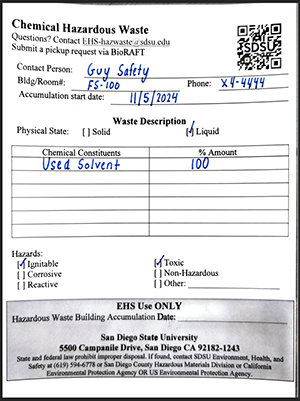Chemical Hazardous Waste
Chemical Hazardous Waste
Hazardous chemical waste is a type of waste that contains substances that are harmful or potentially harmful to human health and the environment. This waste can be generated from various sources, including laboratories, healthcare facilities, and facilities operations
Characteristics of hazardous chemical waste include:
- Toxicity: Substances that can cause harm or death when ingested, inhaled, or absorbed through the skin.
- Corrosivity: Materials that can corrode metals or damage living tissue.
- Ignitability: Waste that can easily catch fire and burn under normal conditions.
- Reactivity: Substances that are unstable or can react violently with other materials.
Examples include solvents, heavy metals, batteries, pesticides, and certain pharmaceuticals. Due to the potential risks associated with hazardous waste, it requires careful handling, storage, and disposal according to strict regulations to minimize its impact on health and the environment.
Chemical Hazardous Waste Labels can be obtained through EH&S by submitting a Hazardous Waste request in BioRAFT/SciShield or emailing us at [email protected].
Hazardous waste containers must have a completed chemical hazardous waste label attached at the time chemical hazardous waste is first added to the container.
The chemical hazardous waste label must be completed with:
- Contact person: the person EH&S can contact with questions about the hazardous waste
- Phone number: Contact person’s phone number
- Building and room#: Where the chemical hazardous waste container is used to collect chemical hazardous waste
- Accumulation Start Date: the date the first drop of liquid or the first article of solid chemical hazardous waste went into the container
- Chemical Components: The identity or identities of the ingredient(s) of the chemical hazardous waste container
- Hazard Boxes: check the SDS’s for the hazards of the waste and check the appropriate boxes.
- Physical State: Solid or Liquid
Hazardous Waste Label Example

SAA’s are the laboratories, shops, and studios where the chemical hazardous waste first starts being accumulated, also called points of generation. The point of generation needs to be under the control of the person(s) producing the waste which means it can not be moved from one place to another and needs to stay in one room.
Chemical hazardous waste accumulation containers can be used for up to 9 months after the start of the accumulation date written on chemical hazardous waste labels. Chemical hazardous waste must be given to EH&S after no longer than 9 months (or 3 days after the quantity limit has been reached).
Submit a pickup request through BioRAFT/SciShield or email [email protected] for removal.
All hazardous materials must be stored in a manner to prevent spills and uncontrolled reactions. The chemical hazardous waste must be compatible with the container that it is being stored in.
Keep the following incompatibles segregated and/or in secondary containment:
- Acids and bases
- Corrosives and flammables
- Corrosives and oxidizers
- Flammables and oxidizers
- Water reactives and aqueous solutions
Submit a pickup request through BioRAFT/SciShield or email [email protected] for removal.
Containers should be free of any solids or liquid material.
